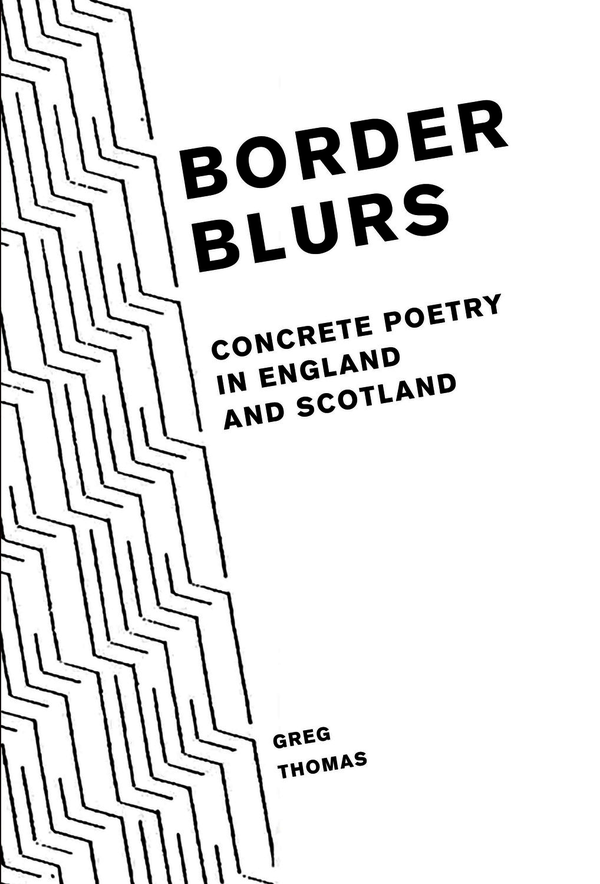The Birkbeck Contemporary Poetics Research Centre (CPRC) invites you to the launch of Border Blurs: Concrete Poetry in England and Scotland (Liverpool University Press). We are celebrating the launch of Greg Thomas’ fantastic book with an evening of papers and discussion on the practice of Concrete Poetry in both its British and international contexts.
Location: Room B13, 43 Gordon Square, School of Arts, Birkbeck University
Time: 6-9pm
Date: 5 December 2019
You can get a free ticket on Eventbrite: https://www.eventbrite.co.uk/edit?eid=81343214745
About the Launch
6 pm – Welcome and Reception
6:15 – Introductions Steve Willey, Lecturer in Creative and Critical Writing, Birkbeck and Director of the CPRC
6:20 – Greg Thomas, ‘Ian Hamilton Finlay, Albert Speer and the Ideology of the (Concrete) Aesthetic’
6:35 – ‘Exploring Border Blurs’ a Q&A with Bronac Ferran and Greg Thomas
6:50 – Bronac Ferran, ‘Letters to Mayer’
7:05 – Nicola Simpson, ‘dsh and yantramantra: typestract as poemscore and prayer’
7:20 – Interval
7:35 – Matt Martin, ‘Ports in a Storm: Bill Griffiths’ Forming Four Dock Poems’
7:50 – Rebecca Kosic, ‘Transatlantic Connections: Concrete poetry in the American Hemisphere’
8:05 pm – General Q&A Chaired by Steve Willey
8:30-9 pm – End
About the participants
Dr Greg Thomas Greg is an independent scholar and recent British Academy Postdoctoral Fellow based in London.
Dr Rebecca Kosick is Lecturer in the School of Modern Languages at the University of Bristol and Co-Director of the Bristol Poetry Institute. She is the author of two books forthcoming in 2020: Material Poetics in Hemispheric America: Words and Objects, 1950-2010 (Edinburgh University Press) and a poetry collection, Labor Day (Golias Books).
Matt Martin is Stuart Hall Research Scholar at Birkbeck, researching the use of nation language and dialect in avant-garde poetry. His own poetry collections include full spectrum apotheosis (Contraband Books) and the dotted line (Gang Press). He maintains the event listings page Innovative Poetry Readings in London (http://www.bbk.ac.uk/cprc/readings).
Bronac Ferran is a PhD candidate in English and the Humanities at Birkbeck working on Hansjörg’s Mayer’s ‘typoems’ of the nineteen sixties. She is the author of ‘The Smell of Ink and Soil: The Story of Edition Hansjörg Mayer’ (2017) and the recently appointed Manager of the Institute for the Humanities at Birkbeck.
Dr Nicola Simpson is a curator and researcher at Norwich University of the Arts. Her interests are in discussing, experiencing and performing the influence of Zen and Tantric Buddhisms on British counter-cultural art and writing. She is editor of The Cosmic Typewriter: The Life and Work of Dom Sylvester Houédard (Occasional Papers, 2012) and co-editor of Dom Sylvester Houédard (Richard Saltoun, Riding House, 2017).
About Border Blurs
This book offers the first in-depth account of the relationship between English and Scottish poets and the international concrete poetry movement of the 1950s to the 1970s. Concrete poetry was a literary and artistic style which reactivated early twentieth-century modernist impulses towards the merging of artistic media, while simultaneously speaking to a gamut of contemporary contexts, from post-1945 reconstruction to cybernetics, mass media and the sixties counter-culture. The terms of its development in England and Scotland suggest new ways of mapping ongoing complexities in the relationship between the two national cultures, and of tracing broader sociological and cultural trends in Britain during the 1960s and 1970s. Focusing especially on the work of Ian Hamilton Finlay, Edwin Morgan, Dom Sylvester Houédard and Bob Cobbing, Border Blurs is based on new and extensive archival and primary research, and will fill a vital gap in contemporary understandings of an important but much misunderstood genre: concrete poetry. It will also serve as a vital document for scholars and students of twentieth-century British literature, modern intermedia art and modernism, especially those interested in understanding modernism’s wide geographical spread and late twentieth-century legacies.




Recent Comments